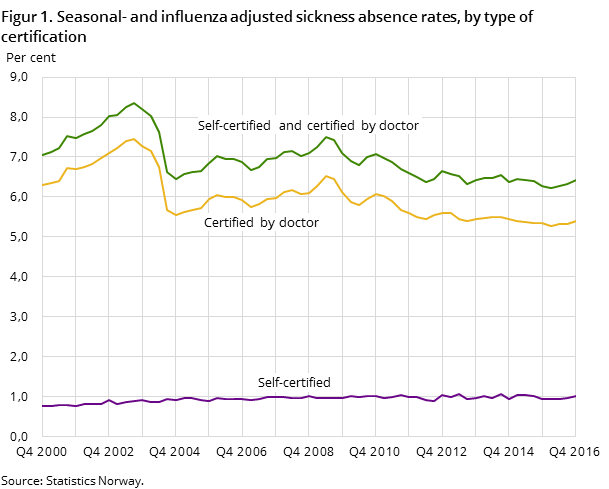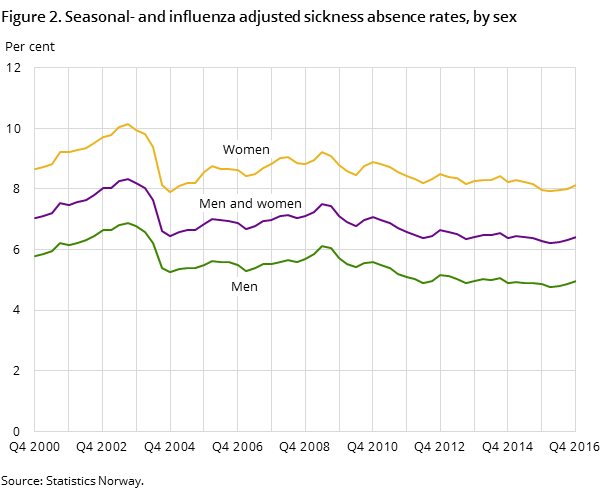Content
Published:
This is an archived release.
Small increase in sickness absence
Sickness absence adjusted for seasonal and influenza variations was 6.4 per cent in the 4th quarter of 2016; a small increase from 6.3 per cent from the last quarter.
| 4th quarter 2016 | Per cent from previous quarter | |
|---|---|---|
| 1The sickness absence rates are shown to two decimal points. In other tables the rates are shown with one decimal point. More decimal points are used when calculating the rates of change in order to get more accurate figures. These will therefore differ slightly from the rates of change produced when using the published rounded figures. | ||
| Both sexes | ||
| Self-certified and certified by doctor | 6.42 | 1.6 |
| Self-certified | 1.03 | 5.1 |
| Certified by doctor | 5.39 | 1.0 |
| Males | ||
| Self-certified and certified by doctor | 4.97 | 2.0 |
| Self-certified | 0.89 | 4.8 |
| Certified by doctor | 4.08 | 1.4 |
| Females | ||
| Self-certified and certified by doctor | 8.11 | 1.3 |
| Self-certified | 1.19 | 5.3 |
| Certified by doctor | 6.92 | 0.7 |


The self-certified absence rose by 5.1 per cent and the doctor-certified absence increased by 1 per cent. Sickness absence for men rose by 2 per cent and by 1.3 per cent for women.
The figures from the 1st quarter of 2015 and onwards are based on a new register called “A-ordningen”. This transition has had a small, but observable, effect on the sickness absence rate on an aggregated level. This effect is discussed further down in the article.
Compared with the sickness absence in the 2nd quarter of 2001, when the IA agreement was signed, there has been a 10.4 per cent decrease in the seasonal and influenza-adjusted sickness absence. This figure is adjusted for the aforementioned effect of the transition to the new register.
New register from 2015Open and readClose
The transition in the 1st quarter of 2015 from the Employers and employees register to “A-ordningen” resulted in a somewhat different figure for employees. This is due to both a somewhat broader coverage of the group and the fact that the quality is better. The transition has had a small, but observable, effect on the sickness absence rate on an aggregated level. This effect is discussed further down.
The effect of the new registerOpen and readClose
The effect of the introduction of a new register from the 1st quarter of 2015 on the sickness absence rate is very small. This includes both the self-reported and the doctor-reported sickness absence rates. However, since the self-reported absence is lower than the doctor-reported absence, the small effect has a higher impact on the change of the self-reported absence than the doctor-reported and the total absence. The table below shows the change (measured in per cent) in seasonal and influenza-adjusted figures from the 2nd quarter of 2001 to the 4th quarter of 2016, both adjusted and not adjusted for the effect of the introduction of the new register from the 1st quarter of 2015.
Change in per cent, Q2 2001 – Q4 2016 | Self- and doctor reported | Self-reported | Doctor-reported |
| Adjusted | -10.4 | 34.7 | -15.8 |
| Not adjusted | -11.0 | 28.0 | -15.9 |
Contact
-
Arbeidsmarked og lønn
E-mail: arbeidsmarked@ssb.no
-
Unn H. Høydahl
E-mail: unnh.hoydahl@ssb.no
tel.: (+47) 40 90 23 77
